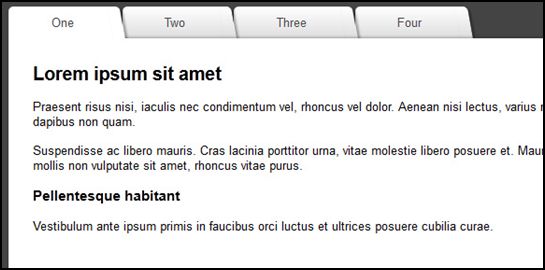How to Create CSS3 and jQuery Folder Tabs
Calatin Rosu creates a sleek CSS3 and jQuery folder tabs that can be useful in updating your site’s look. He uses the same procedures in creating good-looking CSS3 tabs. Here’s how you can do it.
HTML
<ul id="tabs">
<li><a href="#" name="tab1">One</a></li>
<li><a href="#" name="tab2">Two</a></li>
<li><a href="#" name="tab3">Three</a></li>
<li><a href="#" name="tab4">Four</a></li>
</ul> <div id="content">
<div id="tab1">...</div>
<div id="tab2">...</div>
<div id="tab3">...</div>
<div id="tab4">...</div>
</div>
CSS
#tabs{ overflow: hidden; width: 100%; margin: 0; padding: 0; list-style: none; } #tabs li{ float: left; margin: 0 .5em 0 0; } #tabs a{ position: relative; background: #ddd; background-image: linear-gradient(to bottom, #fff, #ddd); padding: .7em 3.5em; float: left; text-decoration: none; color: #444; text-shadow: 0 1px 0 rgba(255,255,255,.8); border-radius: 5px 0 0 0; box-shadow: 0 2px 2px rgba(0,0,0,.4); } #tabs a:hover, #tabs a:hover::after, #tabs a:focus, #tabs a:focus::after{ background: #fff; } #tabs a:focus{ outline: 0; } #tabs a::after{ content:''; position:absolute; z-index: 1; top: 0; right: -.5em; bottom: 0; width: 1em; background: #ddd; background-image: linear-gradient(to bottom, #fff, #ddd); box-shadow: 2px 2px 2px rgba(0,0,0,.4); transform: skew(10deg); border-radius: 0 5px 0 0; } #tabs #current a, #tabs #current a::after{ background: #fff; z-index: 3; } #content { background: #fff; padding: 2em; height: 220px; position: relative; z-index: 2; border-radius: 0 5px 5px 5px; box-shadow: 0 -2px 3px -2px rgba(0, 0, 0, .5); }
jQuery
<script src="http://code.jquery.com/jquery-1.7.2.min.js"></script> <script> $(document).ready(function() { $("#content div").hide(); // Initially hide all content $("#tabs li:first").attr("id","current"); // Activate first tab $("#content div:first").fadeIn(); // Show first tab content $('#tabs a').click(function(e) { e.preventDefault(); if ($(this).closest("li").attr("id") == "current"){ //detection for current tab return } else{ $("#content div").hide(); //Hide all content $("#tabs li").attr("id",""); //Reset id's $(this).parent().attr("id","current"); // Activate this $('#' + $(this).attr('name')).fadeIn(); // Show content for current tab } }); }); </script>
View the live DEMO.
Click on the image to see the full tutorial.








1 Comment
saha
07.11.2012
Demo is interesting. Can I add images instead of text in the content area?
There are no trackbacks to display at this time.